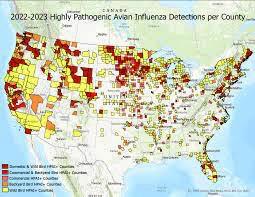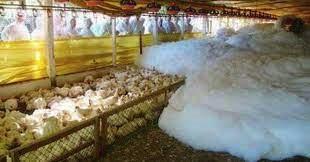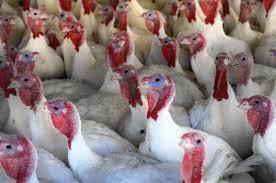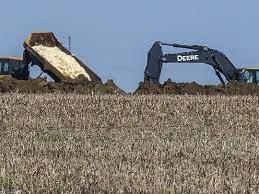 As HPAI resurfaces in the Canadian and U.S. poultry industries, we can expect spurious and unsubstantiated claims for disinfectants, air purification and other measures to protect flocks. A recent presentation by a poultry farmer in Canada was widely circulated creating a misplaced anticipation of protection. The promoters claim that hydroxyl free-radicals generated by UV radiation will destroy HPAI. This is a valid assertion under laboratory or restricted and controlled conditions. The challenges inhibiting destruction of influenza virus within a building housing a large flock relate to volume of air movement, the quantum of virus and environmental conditions including suspended dust within a poultry house.
As HPAI resurfaces in the Canadian and U.S. poultry industries, we can expect spurious and unsubstantiated claims for disinfectants, air purification and other measures to protect flocks. A recent presentation by a poultry farmer in Canada was widely circulated creating a misplaced anticipation of protection. The promoters claim that hydroxyl free-radicals generated by UV radiation will destroy HPAI. This is a valid assertion under laboratory or restricted and controlled conditions. The challenges inhibiting destruction of influenza virus within a building housing a large flock relate to volume of air movement, the quantum of virus and environmental conditions including suspended dust within a poultry house.
Applying chemicals or irradiation, it is necessary for the agent to interact with the virus and achieve effective deactivation. This cannot be accomplished under practical commercial conditions. A typical aviary compartment holding 100,000 hens will require 1.5 cfm per lb. of bird weight. This will be accomplished with an air displacement rate of 600,000 cfm, with between 8 to 12 fans operating depending on rated capacity. It is also noted that HPAI or ND virus will be entrained on dust particles, further inhibiting contact between the virucidal activity of either irradiation or an aerosol disinfectant to achieve absolute inactivation. Unfortunately, HPAI is an all-or-nothing situation for susceptible flocks. Introduction of the virus into a non-immune flock will result in rapid intraflock dissemination. Within days infection will spread through a flock and result in clinical disease manifest by rapidly ascending mortality. Rapid diagnosis applying PCR followed by application of established protocols for control including quarantine and depopulation will result in the loss of the entire flock on a farm or complex. There are no degrees of HPAI, either the flock is infected or it is not. Measures that only ameliorate exposure, even up to 99 percent effectiveness are useless in practice.

Application of UV treatment of air to destroy viral and bacterial pathogens is not a new application. During the 1980s, installations were developed in Israel to improve the health of broiler, turkey and egg-production flocks in modern controlled environment housing. These units were erected as the industry moved from simple suspended cages and open-sided sheds as used in California 50 years ago to more modern intensive installations. At the time, claims were made regarding protection of flocks from Newcastle disease but it is noted that all flocks were comprehensively protected using available vaccines.
With the advent of a catastrophic infection such as HPAI, unscrupulous or in some cases well-meaning entrepreneurs promote “the next big thing” This is usually an adaptation of existing technology that may be effective in specific applications such as operating theaters but is inappropriate and impractical for large-scale poultry production.
Some of the spurious claims made over the years to protect flocks include:-
- Disinfectants that effectively kill a range of viruses under laboratory conditions are frequently advanced as a protective modality against HPAI and ND in large houses. Ensuring direct and sustained contact between the virus entrained in an incoming air stream and the virucidal agent over an adequate period to achieve total kill before contact with individual birds has yet to be achieved.
- Some products are promoted as an aid to enhance immune function. These include botanicals, extracts of yeast cell walls, and compounds with a range of claims regarding beneficial effects. If there were a practical approach to absolutely inactivate HPAI or for that matter any other pathogenic virus significant to human or veterinary medicine, there would by now have been extensive application.
Since it generally conceded that HPAI virus may enter poultry housing by the aerogenous route, filtration of incoming air has been suggested as a possible means of protection. Again, in theory HEPA filtration could be an effective approach in the context of housing small groups of SPF birds or for holding birds under laboratory research conditions. The resistance associated with levels of filtration adequate to protect a poultry house would involve levels of air displacement and energy requirements inconsistent with commercial applications. Since HPAI virus is introduced into houses via air inlets, screening against dust that entrains and protects pathogens may reduce the quantum of virus entering a house. As previously indicated infection is essentially an all or nothing phenomenon. The quantum of virus required to initiate infection under practical conditions is probably quite small as denoted by outbreaks attributed to the dissemination of virus by migratory waterfowl in the vicinity of a farm.

Given the current approach to control of highly pathogenic avian influenza requiring rapid diagnosis and depopulation with disposal of flocks as quickly as possible mitigates against measures that provide partial protection, including chemicals or physical disruption of viruses by some form of irradiation. To maintain otherwise and promote commercial applications and installations with unsubstantiated claims represents either a fraud or well-meaning aspiration.
At present, health professionals and regulatory agencies including our own, promote biosecurity. In many cases deficiencies have allowed virus to be tracked onto farms on fomites. Many of the outbreaks especially those on large egg production units appear to be associated with proximity of migratory waterfowl known to serve as reservoirs and disseminators of avian influenza virus. Attempting to absolutely interdict entry of virus into houses by air filtration appears impractical. Inactivating influenza virus by chemical or physical applications will be equally ineffective in preventing outbreaks even with 99.9 percent efficacy.
Ultimately regulatory authorities will recognize that establishing and maintaining well immuned populations through vaccination is the only long-term practical method of minimizing losses from HPAI. Avian influenza attributed to the H5N1 strain has persisted in migratory birds, backyard flocks and with sporadic outbreaks in commercial poultry for at least three years. As a panornitic disease, HPAI persists in regions of Asia, Africa and Europe and with recent extension to the Americas. Since HPAI virus is disseminated by migratory marine birds and waterfowl, eradication is not a feasible objective even in the intermediate term. Currently we rely on a combination of structural and operational biosecurity to reduce the number of outbreaks. The unfortunate reality in the U.S. is the location of large farms in areas frequented by migratory waterfowl. This is contrary to accepted principles of conceptual biosecurity and in all cases cannot be overcome by intensified and high-level structural and operational biosecurity. Ultimately vaccination in combination with biosecurity will be adopted by the world’s poultry industries. This is based on the emerging reality that HPAI is now a panornitic that appears to be seasonally increasing in incidence rate among commercial farms.
The world’s industries have eliminated Newcastle disease as a major restraint to production through vaccination. The same approach will be appropriate for HPAI. This will however require modification of rules governing trade.
Irrespective of how control and prevention at the regulatory level is implemented, we should resist the promise of “quick fixes” that have no prospect of practical application irrespective of claims loosely based on valid scientific principles.